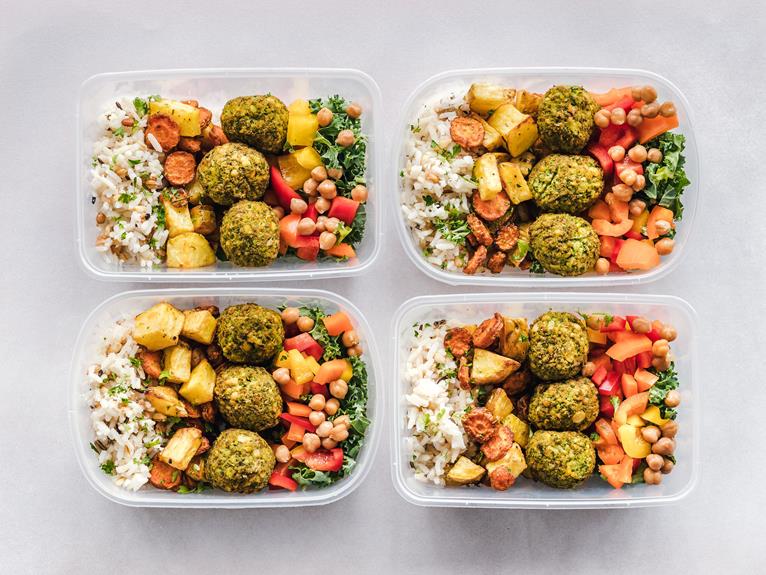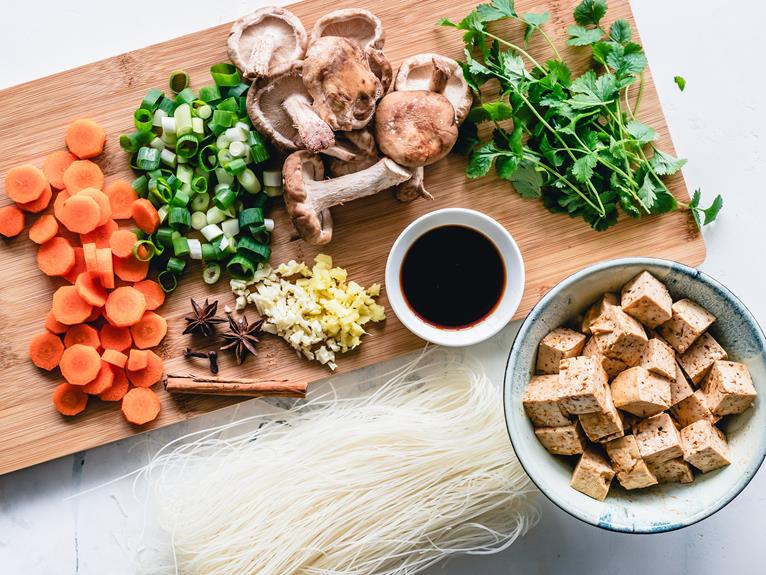According to a recent survey, 50% of parents struggle to get their picky eaters to eat a balanced diet. If you're one of those parents, don't worry because you're not alone. Trying to introduce nutritious foods to your little ones can be tiring.
But fear not, because we have 13 nutritional hacks that are sure to please even the pickiest eaters. These simple yet effective strategies will help you sneak in essential nutrients and make mealtimes more enjoyable for the whole family.
So get ready to discover some clever ways to transform your picky eater into a healthy eater, one bite at a time.
Sneak Vegetables Into Their Favorite Dishes
If you have a picky eater at home, one effective way to increase their vegetable intake is by adding vegetables to their favorite dishes. By incorporating veggies into their go-to meals, you can make sure they get essential nutrients while still enjoying the flavors they love.
Veggie-packed desserts are a great choice to entice even the fussiest eaters. For example, you can add grated zucchini or carrot to your homemade brownies or muffins. The vegetables not only boost the nutritional value of the treats but also add moisture and richness.
Another clever trick is to make vegetable-infused drinks. Smoothies are a fantastic option for this. You can blend spinach, kale, or avocado with fruits like bananas or berries to create a delicious and nutritious beverage. The sweetness of the fruits hides the taste of the vegetables, making it a perfect choice for picky eaters who may be hesitant to eat them otherwise.
Sneaking vegetables into their favorite dishes not only helps your picky eater get the nutrients they need but also ensures they've a well-rounded diet, all while enjoying the meals they love.
Make Smoothies With Hidden Fruits and Vegetables
Create Delicious and Nutritious Smoothies With Hidden Fruits and Vegetables
Blend fruits and vegetables together to make smoothies that even picky eaters will love. Smoothies are a fantastic way to sneak in some extra veggies for your child without them even noticing.
Here are some creative and tasty smoothie recipes that will leave your picky eaters asking for more:
- Berry Blast: Blend a handful of spinach, mixed berries, a banana, and almond milk. The natural sweetness of the berries will cover up the taste of the spinach, making it a great option for those who are hesitant about greens.
- Tropical Paradise: Mix pineapple, mango, spinach, and coconut water for a refreshing and tropical smoothie. The vibrant flavors of the fruits will overpower the taste of the spinach, resulting in a delicious and healthy treat.
- Green Monster: Combine kale, cucumber, apple, and lemon juice for a green smoothie packed with nutrients. The sweetness of the apple and the tanginess of the lemon will balance out the flavors of the vegetables, creating a tasty and nutritious option.
- Choco-Banana Delight: Blend spinach, banana, almond milk, and a tablespoon of cocoa powder for a healthy chocolate smoothie. The sweetness of the banana and the richness of the cocoa will hide the taste of the spinach, making it a guilt-free dessert-like treat.
With these hidden veggie recipes, you can create smoothies that not only taste amazing but also provide essential nutrients. So grab your blender and start blending your way to a healthier and happier picky eater.
Experiment With Different Cooking Methods
Expand Your Picky Eater's Palate with Different Cooking Methods
To help your picky eater try new foods, it's time to experiment with different cooking methods. By using various techniques, you can transform familiar ingredients into exciting dishes that your picky eater may be more willing to try. Let's get creative in the kitchen and explore different ways to prepare their favorite foods.
To start, here are some cooking methods you can try:
Grilling: Cook food over direct heat for a smoky and charred flavor. You can try grilled chicken, vegetables, or fruit kebabs.
Roasting: Bake food in the oven at high heat to achieve a crispy exterior and tender interior. Roasted potatoes, carrots, or Brussels sprouts are great options.
Stir-frying: Quickly cook food in a hot pan with a small amount of oil to retain vibrant colors and nutrients. Stir-fried chicken with vegetables or tofu with broccoli are delicious choices.
Steaming: Cook food with steam to preserve natural flavors and nutrients. Steamed fish, broccoli, or dumplings are healthy and tasty options.
Baking: Cook food surrounded by dry heat in the oven to achieve a golden crust. Try baked salmon, chicken nuggets, or muffins for a satisfying meal.
Incorporate Healthy Ingredients Into Homemade Snacks
Let's discuss incorporating healthy ingredients into homemade snacks. It's a great way to sneak in essential nutrients while still satisfying your picky eater's cravings. Here are four ways you can do this:
- Use whole grain alternatives like whole wheat flour or oat flour instead of refined flour. These options are higher in fiber and provide more vitamins and minerals.
- Replace regular sugar with natural sweeteners like honey, maple syrup, or mashed bananas. Not only do they add natural sweetness, but they also provide additional nutrients.
- Add fruits and vegetables to your snacks. You can grate carrots or zucchini in muffins or use pureed fruits like applesauce or pumpkin in cookies. This adds moisture and natural sweetness, making the snacks healthier and more flavorful.
- Incorporate nuts, seeds, or nut butter into your snacks for added protein and healthy fats. Sprinkle chopped almonds or chia seeds on top of your baked goods or use almond butter instead of regular butter.
By making these simple substitutions and additions, you can transform your homemade snacks into nutritious and delicious treats for your picky eater.
Give it a try and see how they enjoy the healthier options!
Serve Meals in Creative and Appealing Ways
Make mealtime more appealing for your picky eater by getting creative with how you serve meals. Instead of using fancy language, keep it simple and straightforward.
Use colorful placemats, fun-shaped plates, and vibrant utensils to create an exciting dining experience. Arrange the food in visually appealing ways, like making a smiley face out of fruits or arranging veggies into a rainbow shape.
You can also use food art and garnishes to make meals more enticing. Transform a plain sandwich into a work of art by using cookie cutters to make fun shapes or adding colorful vegetable slices as toppings. Sprinkle herbs or grated cheese on top of dishes to make them look more appetizing.
Another idea is to create mini skewers with a combination of fruits, vegetables, and cheese to make eating more interactive and enjoyable.
Don't forget to involve your picky eater in the process. Let them help choose the table settings or create food art. By including them, they'll feel a sense of belonging and be more excited to try new foods.
Use Spices and Herbs to Enhance Flavors
Enhancing the flavors of your meals is simple and beneficial. By incorporating a variety of spices and herbs, you can add depth and complexity to your dishes. Here are some suggestions to help you enhance the flavors of your meals:
- Try spice blends: Experiment with pre-made spice blends like curry powder, Italian seasoning, or Cajun spices. These blends are expertly crafted to create a harmonious balance of flavors.
- Toast your spices: Before adding spices like cumin seeds or coriander seeds to your dish, toast them in a dry pan. This releases their natural oils and intensifies their flavors.
- Use fresh herbs: Elevate the taste of your meals by adding fresh herbs like basil, cilantro, and mint. Whether you include them in sauces, salads, or as a garnish, they'll brighten up your dishes.
- Pair complementary spices: Certain spices naturally complement each other. For example, cinnamon and nutmeg work well together in sweet dishes, while cumin and coriander create a flavorful base for savory dishes.
Create Homemade Versions of Their Favorite Unhealthy Foods
To please picky eaters while encouraging healthier choices, try making homemade versions of their favorite unhealthy foods. By adding nutritious ingredients and getting creative with presentation, you can give their go-to dishes a healthy makeover that's visually appealing.
Start with their beloved comfort foods like pizza or burgers and give them a nutritious twist. Use whole wheat crust for the pizza and top it with colorful veggies like bell peppers, mushrooms, and spinach. Instead of traditional beef burgers, go for lean turkey or veggie patties and serve them on whole grain buns.
Mac and cheese, another popular choice, can be transformed into a healthier option. Swap regular pasta with whole grain or chickpea pasta and use reduced-fat cheese or a mix of cauliflower and cheese sauce for a creamy texture.
Get imaginative with how you present the food. Arrange fruits and veggies into fun shapes or use cookie cutters to make sandwiches in various shapes and sizes. Adding colorful garnishes like fresh herbs or edible flowers can also make the dish more visually appealing.
Make Nutritious Dips and Sauces for Dipping
When dealing with picky eaters, it can be helpful to have nutritious dips and sauces on hand. These can add flavor to meals and encourage kids to try new foods. By making your own healthy dressings and dips, you can provide a range of options that are both tasty and packed with essential nutrients.
Here are four ideas to get you started:
- Creamy Avocado Ranch Dressing: Blend ripe avocados with Greek yogurt, fresh herbs, garlic, and a squeeze of lime juice. This creamy and tangy dressing is full of healthy fats and adds a burst of flavor to salads, wraps, and grilled vegetables.
- Spiced Hummus: Create your own hummus by blending chickpeas, tahini, lemon juice, garlic, and a touch of cumin and paprika. This protein-packed dip is perfect for veggies or spreading on whole wheat crackers.
- Greek Tzatziki Sauce: Mix Greek yogurt, grated cucumber, garlic, lemon juice, and dill to make a refreshing and nutritious sauce. Serve it with grilled chicken or use it as a dip for whole grain pita bread and raw veggies.
- Honey Mustard Dip: Combine Greek yogurt, Dijon mustard, honey, and a splash of apple cider vinegar. This sweet and tangy dip pairs well with chicken tenders, roasted vegetables, or as a dressing for mixed green salads.
Try Out Interesting and Colorful Food Presentations
Get creative with your food presentations to make mealtime more exciting and appealing for picky eaters. One way to do this is by incorporating colorful food art and creative food plating. Children are naturally drawn to bright colors, so why not make their meals visually appealing as well as delicious?
Start by arranging fruits and vegetables in fun and visually appealing ways. Use cookie cutters to make shapes out of watermelon, cantaloupe, and honeydew. Arrange them on a plate to resemble a flower or a rainbow. You can also make faces out of sliced fruits and vegetables, using blueberries for eyes, strawberries for lips, and cucumber slices for eyebrows.
Another idea is to create food skewers with a variety of colorful ingredients. Alternate pieces of grilled chicken, cherry tomatoes, and chunks of pineapple on a skewer. Not only does this make the food look more appealing, but it also makes it easier for picky eaters to try new flavors when they're presented in a fun and interactive way.
Use Fun and Engaging Food Names
Now that you've become skilled at creating colorful food presentations, let's take it a step further and discover the power of using fun and engaging food names. This simple yet effective technique can make mealtime exciting and encourage even the pickiest eaters to try new foods.
Here are some reasons why incorporating fun food names can make a difference:
- Sparking curiosity: Get your child's attention with creative names like 'Superhero Salad' or 'Magic Veggie Medley'. This element of surprise and adventure can make mealtime feel like a fun and enjoyable experience, enticing your child to give it a try.
- Creating a sense of ownership: Involve your child in the naming process to give them a sense of pride and ownership over the food they're about to eat. This can boost their confidence and make them more open to trying new things.
- Enhancing food art: Fun food names can complement your colorful food presentations. Imagine serving 'Rainbow Fruit Skewers' or 'Funny Face Pancakes' – not only will they look appealing, but the names will add an extra element of excitement.
- Fostering positive associations: When a food has a fun and engaging name, it becomes associated with positive emotions and experiences. This can help your child develop a positive attitude towards healthy eating and create long-lasting habits.
Make Mealtimes Interactive and Enjoyable
Mealtimes can become interactive and enjoyable experiences for picky eaters by using a few simple strategies. By making mealtimes interactive, you can create an environment that encourages mindful eating and fosters a sense of belonging for your picky eater.
One way to make mealtimes interactive is by involving your child in the meal preparation process. Let them help with simple tasks like washing vegetables or stirring the ingredients. This not only gives them a sense of ownership over the meal but also helps develop their interest in trying new foods.
Another way to make mealtimes enjoyable is by introducing themed meals or fun food presentations. For example, you can have a night where everyone builds their own taco or create a colorful fruit salad with different shapes and sizes. By making the meal visually appealing and exciting, your picky eater may be more willing to give it a try.
You can also incorporate games or challenges into mealtimes. For instance, you can play a game where everyone tries at least one bite of each dish without knowing what it is. This can make the experience more exciting and encourage your child to explore new flavors.
Offer a Variety of Textures in Meals
To make meals more enjoyable for picky eaters, it's important to offer a variety of textures. Picky eaters often have strong preferences when it comes to textures, so introducing new ones can be challenging. However, with some creativity and patience, you can gradually expand their palate and make mealtime more enjoyable.
Here are some tips to incorporate different textures into meals for picky eaters:
- Sneak in vegetables: Picky eaters may avoid vegetables because of their texture. Try pureeing vegetables and adding them to sauces, soups, or smoothies. This way, they won't notice the texture change while still getting the nutritional benefits.
- Mix it up: Combine different textures in a single dish. For example, you can add crunchy toppings like nuts or breadcrumbs to a creamy pasta dish. This creates a contrast of textures that can be appealing to picky eaters.
- Gradual exposure: Introduce new textures slowly. Start by offering small amounts of a new food alongside familiar ones. Encourage them to take small bites and gradually increase the portion over time. This helps them get used to the texture without overwhelming them.
- Experiment with cooking methods: Different cooking methods can change the texture of food. For example, roasting vegetables can make them tender and slightly crispy, while steaming retains their natural crunch. Try different techniques to find the ones that your picky eater prefers.
Get Them Involved in Meal Planning and Preparation
One effective way to encourage picky eaters to try new foods is by involving them in meal planning and preparation. When children have a say in what they eat, they feel a sense of ownership and are more likely to be open to trying new things. To make meal planning and preparation enjoyable, you can introduce them to fun kitchen gadgets that make cooking exciting and engaging. Let them choose their favorite colorful utensils or quirky tools that will spark their interest in the kitchen.
Another great way to involve picky eaters in meal planning is by allowing them to grow their own ingredients. This not only teaches them about where food comes from but also instills a sense of pride in their own creations. You can start a small herb garden or grow some vegetables together. Watching their plants grow and using the ingredients they've grown themselves can be a thrilling experience for picky eaters.
Here are some examples of fun kitchen gadgets and ideas for growing your own ingredients:
- Spiralizer: This gadget can turn vegetables into fun, spiral-shaped noodles. It's a great way to make healthy eating more exciting for picky eaters.
- Mini waffle maker: This compact gadget allows kids to make their own mini waffles in fun shapes. It's a great way to get them involved in breakfast preparation.
- Pancake art kit: This kit includes different shaped molds and squeeze bottles for creating pancake designs. It's a fun way to get picky eaters excited about breakfast.
- Popcorn maker: Making popcorn at home can be a fun and healthy snack option. Let picky eaters choose their own seasonings to personalize their popcorn.
- Fruit slicer: This gadget makes it easy to slice fruits into fun shapes. Kids can create their own fruit salads or use the sliced fruits as toppings for yogurt or pancakes.
In addition to using these fun kitchen gadgets, involving picky eaters in growing their own ingredients can be a rewarding experience. They can start with a small herb garden and gradually move on to growing vegetables like tomatoes, lettuce, cucumbers, and carrots. It's a hands-on way to teach them about the importance of fresh, homegrown ingredients and it may even inspire them to try new foods.
Conclusion
To sum up, these nutritional tips can make a big difference when it comes to pleasing picky eaters.
By sneaking veggies into their favorite dishes and making smoothies with hidden fruits and veggies, you can make sure they're getting the nutrients they need.
It's worth noting that research shows involving kids in meal planning and prep increases their chances of trying new foods by 80%.
So, get creative and make mealtime interactive to make healthy eating fun and enjoyable for everyone.















